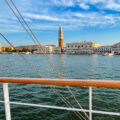
Add Greece to a growing list of destinations charging fees for cruisers to visit on a day in port. Mykonos and Santorini are charging 20 euros per passenger for the summer season from July 1 to Sept. 30. The tax goes down to 12 euros in October and just 4 euros in the winter months.
Other cruise destinations in Greece are charging 5 euros in the peak summer season, 3 euros in the fall and spring, and 1 euro in the winter.
Greek Prime Minister Kyriakos Mitsotakis says it’s a response to the burden of thousands of cruise visitors arriving at tiny islands daily. Santorini can see as many as five ships anchored off the port daily, with hour-long lines for the cable car to the town, which gets packed with pedestrians.
Greece joins a growing list of cruise destinations setting taxes on ships or passengers to help them handle tourist hordes.
Venice is an early adopter, actually banning ships from docking directly in the city and charging arrival fees for daily visitors. And Hawaii, Norway, Mexico and Skagway, Alaska have all recently imposed taxes on ships or fees for cruise passengers to raise revenue and reduce the impacts of overtourism.

In Hawaii the tax revenue from cruise ships is being earmarked for environmental causes, such as park management. In Norway, municipalities that want to implement a 3 per cent tourism tax, which includes cruise ships only if a destination can show that tourists put strain on their municipal services, roads and parks, according to sources.
In Mexico, the Florida-Caribbean Cruise Association helped negotiate $5 per passenger fee starting July 1, a significant reduction from the previously announced $42. But it goes up to $10 in 2026 and $15 in 2027.
The industry group Cruise Line International Association has filed a lawsuit challenging Skagway’s levy and is threatening to sue Hawaii. “If the cruise industry failed to challenge this surcharge, other states and municipalities could feel unconstrained in adopting similar unlawful surcharges, leading to exorbitant and ultimately untenable cruise fares,” a CLIA spokeswoman said.
Since cruise lines have other options, they may begin to avoid taxed destinations, suggests an article in Travel Weekly.
When introducing these taxes, destinations play a balancing act: They want to remain welcoming to tourists to reap the economic benefits, but they also want to keep the local residents content, said Jungho Suh, who teaches management at George Washington University.
“The power to attract tourists or visitors to a local travel destination stems from the local community’s welcoming hospitality, their friendliness, their kindness to visitors, which are deeply rooted in the local community’s overall well-being,” Suh told Travel Weekly.

“There’s a great deal of competition to get cruise ships to dock,” cautioned Robert Rosen, a law professor at the University of Miami who teaches a course on the legal environment of the cruise industry. “In Latin America, Mexico will compete with Guatemala. In the Caribbean, all the islands are competing with each other. So to impose a tax creates a disincentive to visit your country.”
CLIA has warned of “unintended consequences for the local communities,” including “lower spending by cruise guests when their cruise fare costs more and reduced visitation by cruise ships.”
Taxes may also incentivize cruise lines to dedicate more days to their private destinations or as sea days, said New York University’s Richie Karaburun, a clinical associate professor at the Jonathan M. Tisch Center of Hospitality.
When they can’t avoid taxes, they’ll either absorb the fees or pass them along to customers. The latter is more likely, he said.
“If it’s only one destination that adds in $5, they might eat it up,” he said. “If all of a sudden four ports (on a week-long cruise) added $6, that’s $24, and if you look at it, that’s $24 times thousands of people each week. I don’t think any cruise line could actually eat this up, and in the end, they’re just going to have to put that back into their pricing.”








